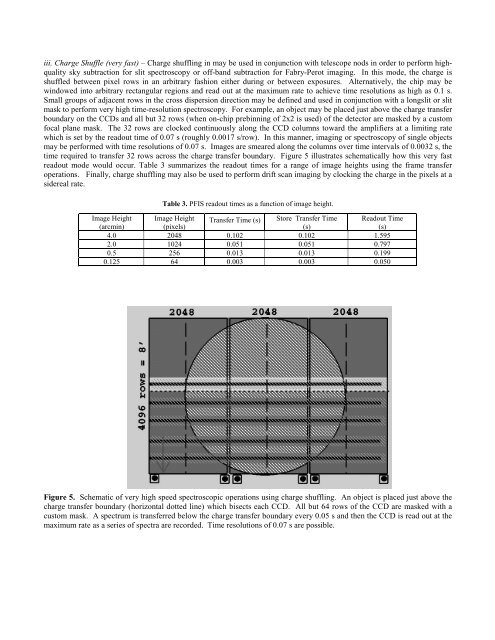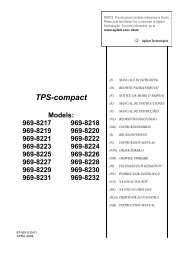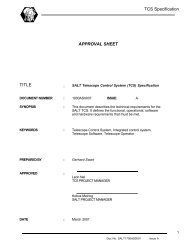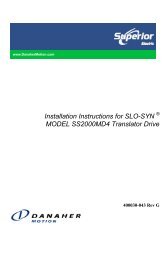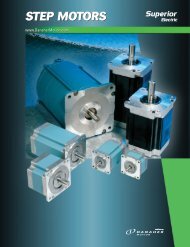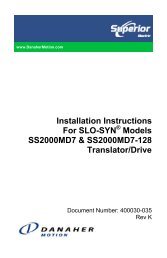The Prime Focus Imaging Spectrograph for the Southern - Space ...
The Prime Focus Imaging Spectrograph for the Southern - Space ...
The Prime Focus Imaging Spectrograph for the Southern - Space ...
You also want an ePaper? Increase the reach of your titles
YUMPU automatically turns print PDFs into web optimized ePapers that Google loves.
iii. Charge Shuffle (very fast) – Charge shuffling in may be used in conjunction with telescope nods in order to per<strong>for</strong>m highquality<br />
sky subtraction <strong>for</strong> slit spectroscopy or off-band subtraction <strong>for</strong> Fabry-Perot imaging. In this mode, <strong>the</strong> charge is<br />
shuffled between pixel rows in an arbitrary fashion ei<strong>the</strong>r during or between exposures. Alternatively, <strong>the</strong> chip may be<br />
windowed into arbitrary rectangular regions and read out at <strong>the</strong> maximum rate to achieve time resolutions as high as 0.1 s.<br />
Small groups of adjacent rows in <strong>the</strong> cross dispersion direction may be defined and used in conjunction with a longslit or slit<br />
mask to per<strong>for</strong>m very high time-resolution spectroscopy. For example, an object may be placed just above <strong>the</strong> charge transfer<br />
boundary on <strong>the</strong> CCDs and all but 32 rows (when on-chip prebinning of 2x2 is used) of <strong>the</strong> detector are masked by a custom<br />
focal plane mask. <strong>The</strong> 32 rows are clocked continuously along <strong>the</strong> CCD columns toward <strong>the</strong> amplifiers at a limiting rate<br />
which is set by <strong>the</strong> readout time of 0.07 s (roughly 0.0017 s/row). In this manner, imaging or spectroscopy of single objects<br />
may be per<strong>for</strong>med with time resolutions of 0.07 s. Images are smeared along <strong>the</strong> columns over time intervals of 0.0032 s, <strong>the</strong><br />
time required to transfer 32 rows across <strong>the</strong> charge transfer boundary. Figure 5 illustrates schematically how this very fast<br />
readout mode would occur. Table 3 summarizes <strong>the</strong> readout times <strong>for</strong> a range of image heights using <strong>the</strong> frame transfer<br />
operations. Finally, charge shuffling may also be used to per<strong>for</strong>m drift scan imaging by clocking <strong>the</strong> charge in <strong>the</strong> pixels at a<br />
sidereal rate.<br />
Table 3. PFIS readout times as a function of image height.<br />
Image Height<br />
(arcmin)<br />
Image Height<br />
(pixels)<br />
Transfer Time (s) Store Transfer Time<br />
(s)<br />
Readout Time<br />
(s)<br />
4.0 2048 0.102 0.102 1.595<br />
2.0 1024 0.051 0.051 0.797<br />
0.5 256 0.013 0.013 0.199<br />
0.125 64 0.003 0.003 0.050<br />
Figure 5. Schematic of very high speed spectroscopic operations using charge shuffling. An object is placed just above <strong>the</strong><br />
charge transfer boundary (horizontal dotted line) which bisects each CCD. All but 64 rows of <strong>the</strong> CCD are masked with a<br />
custom mask. A spectrum is transferred below <strong>the</strong> charge transfer boundary every 0.05 s and <strong>the</strong>n <strong>the</strong> CCD is read out at <strong>the</strong><br />
maximum rate as a series of spectra are recorded. Time resolutions of 0.07 s are possible.


